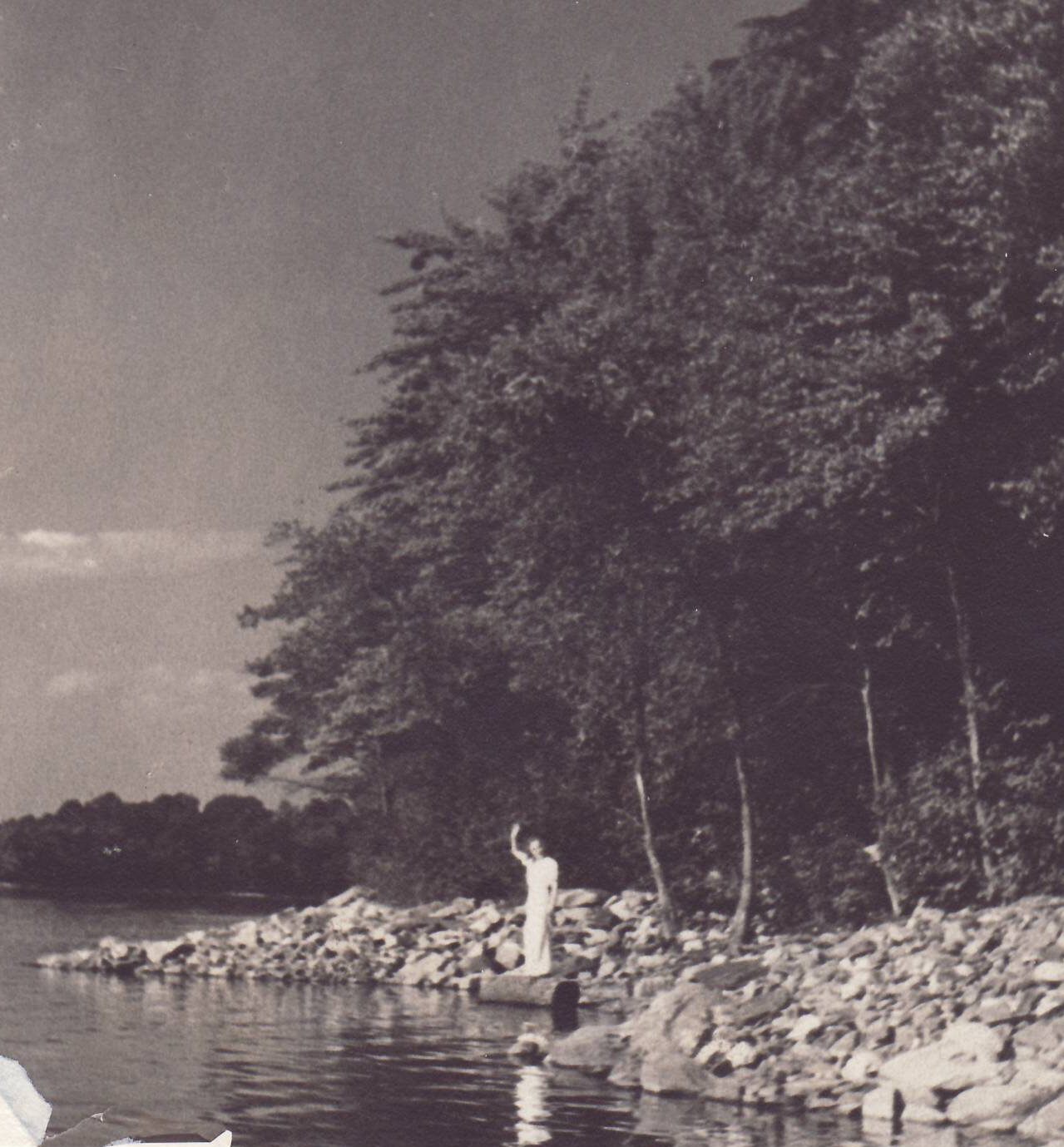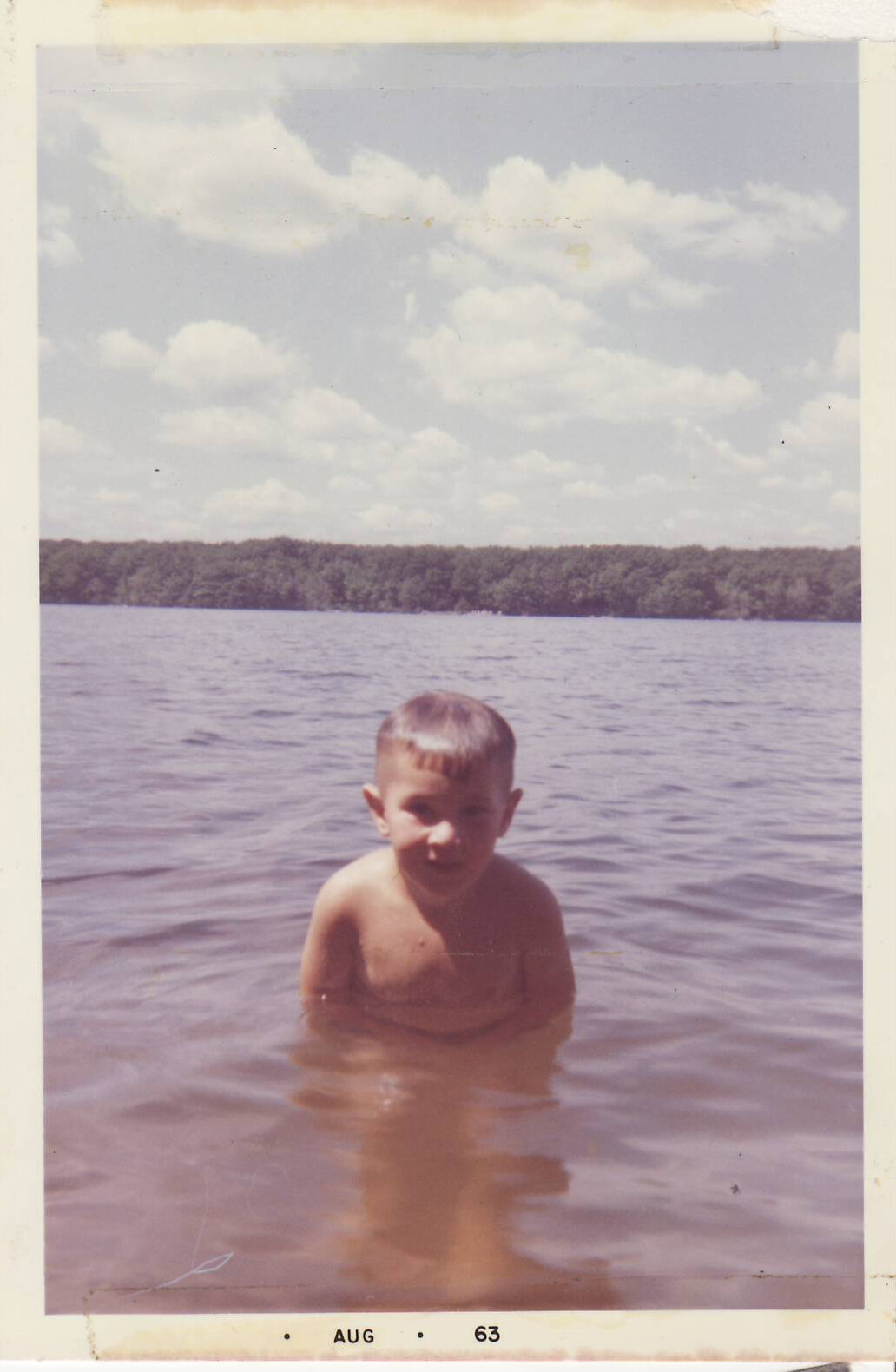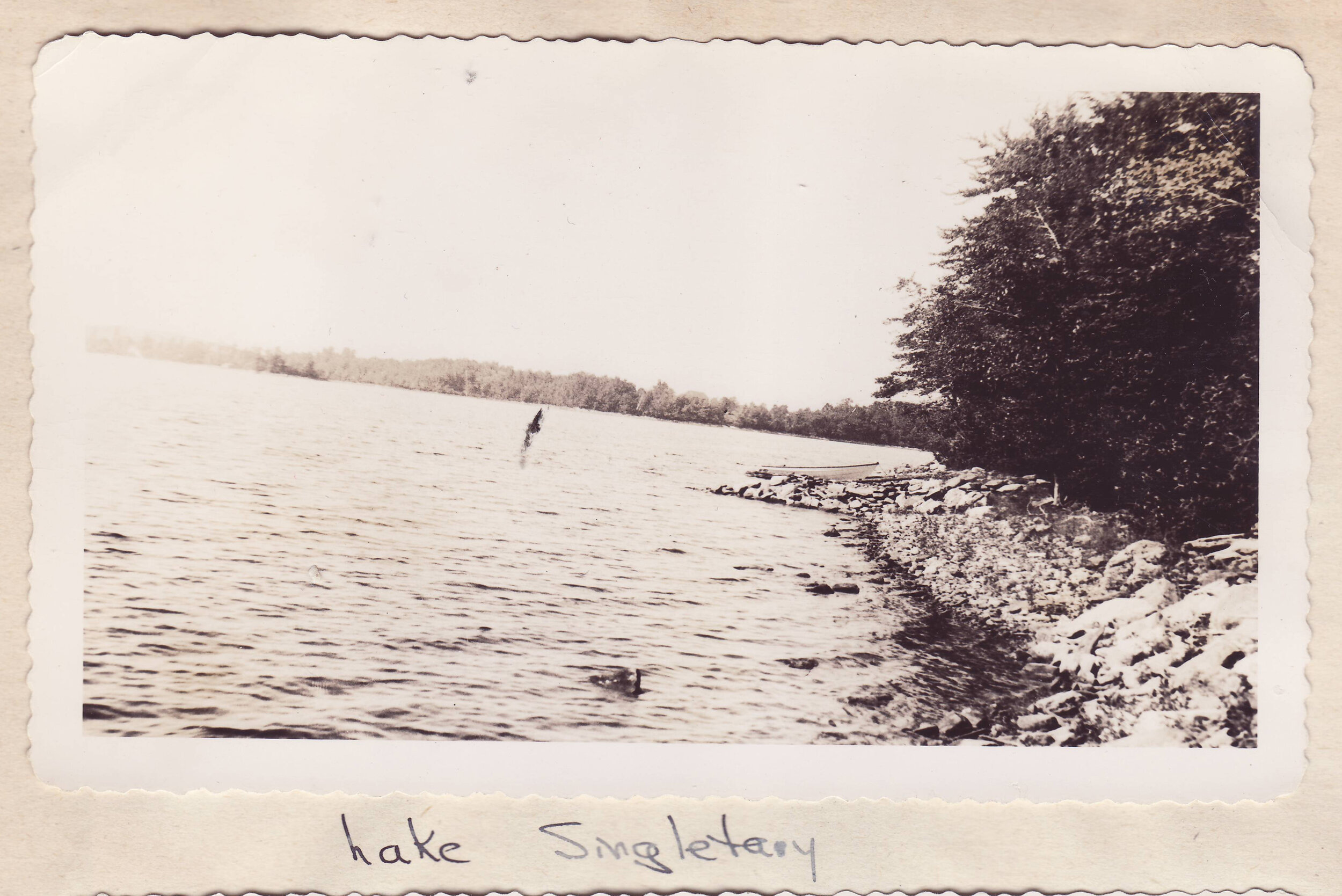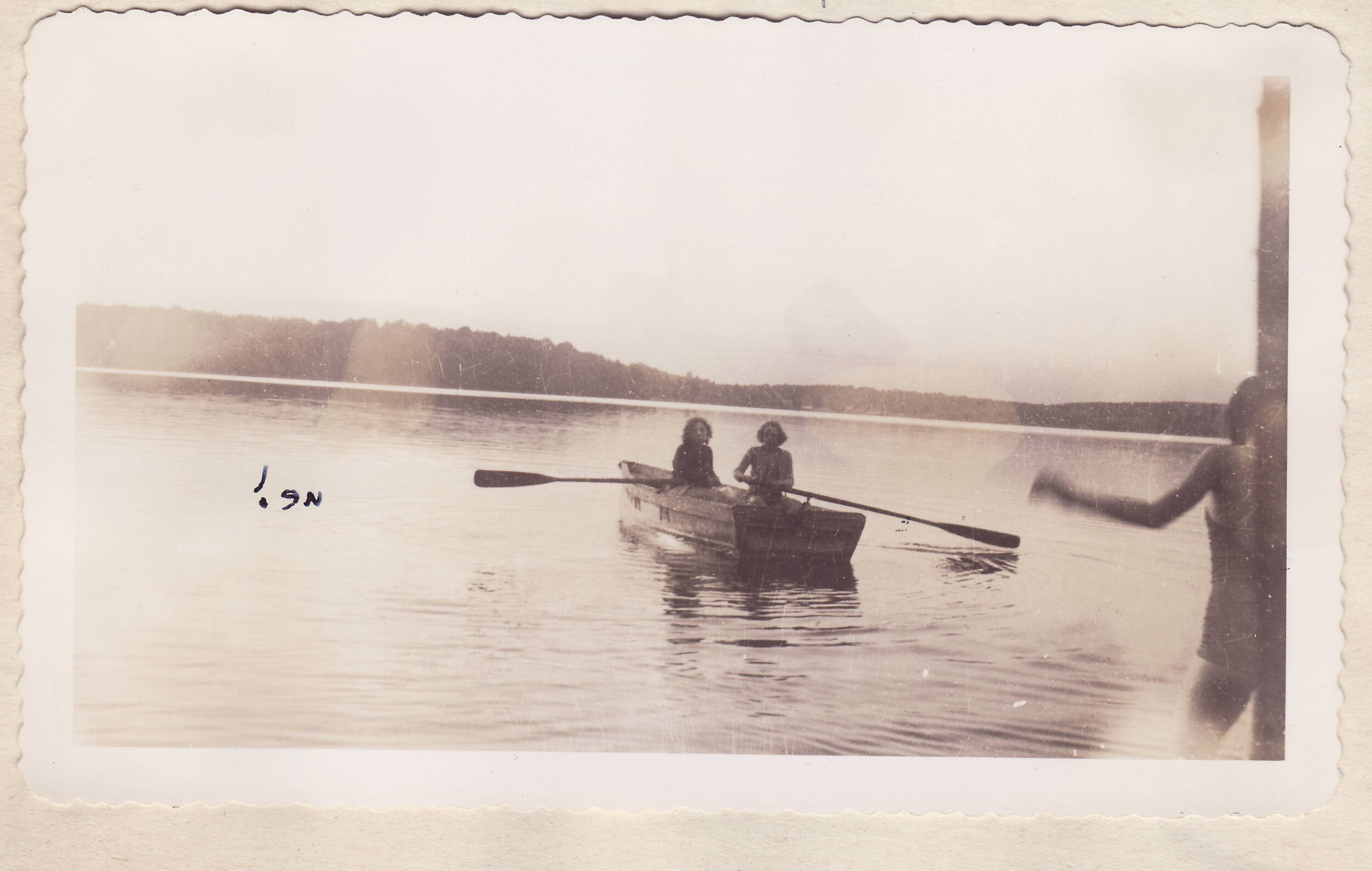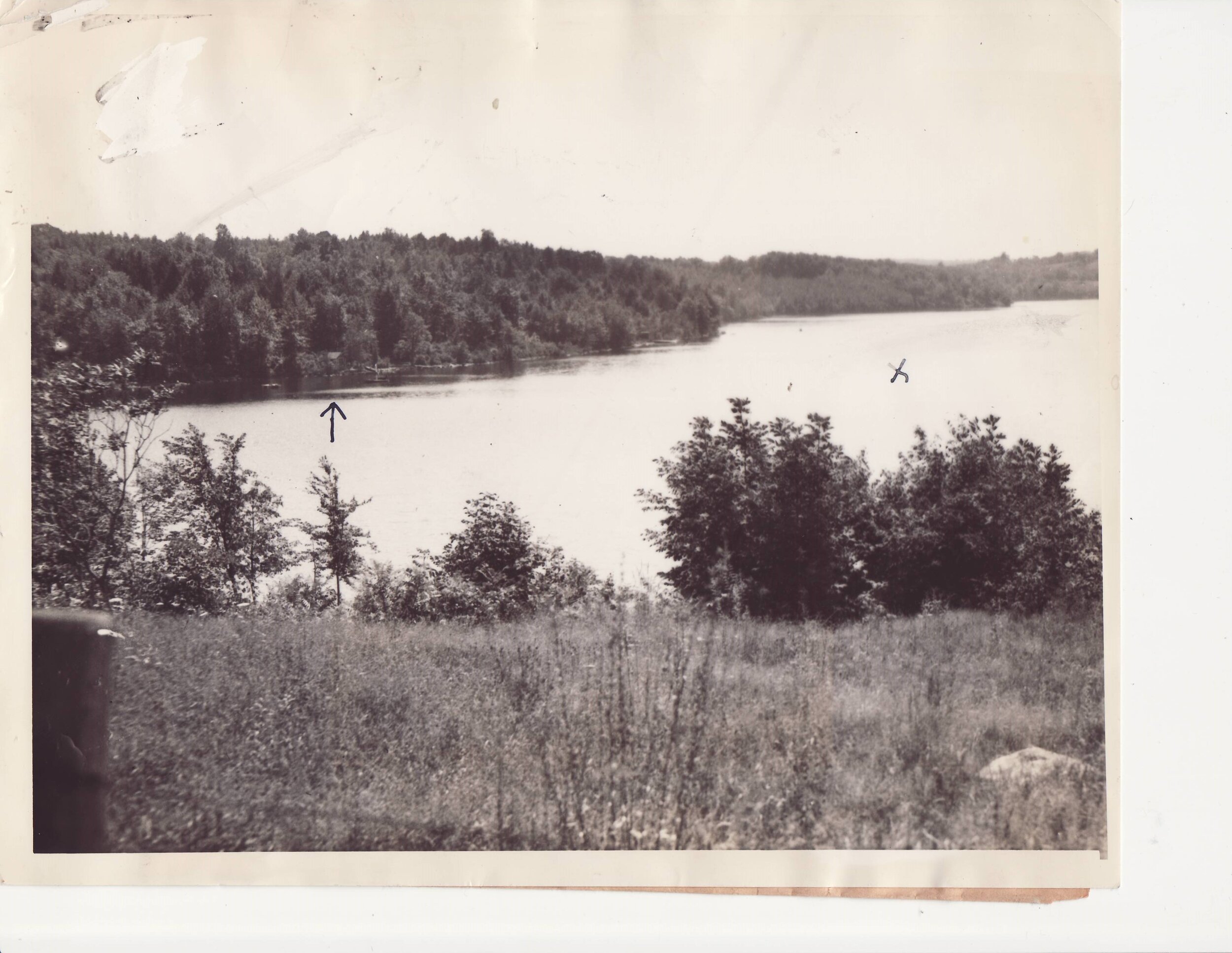Originally Published December 2, 2015 by Steve LeClaire
“Taking the Boston Rd west at Sutton center and continuing to our new and present schoolhouse, directly across you will find a cart road somewhat improved, which leads for about three quarters of a mile through what has been known throughout my lifetime as the Thompson Farm to Lake Singletary. As you finally arrive at the lake, you will be pleasantly surprised to find about an acre of hemlocks and white birches and some cleared land which it has been said was used as an old Indian burial ground. I have found nothing to substantiate this fact but it is a beautiful spot with a lovely view of the lake. The shore line is packed wide and deep with rocks brought there by oxcart to clear the farm land.
On the right of this acre of land, bordering Stephen Benjamin’s wall, is a rustic cabin built in 1939 by F. Hazen Bordeaux and still owned by him. This cabin is lined with knotty pine and has large beams supporting the ceiling and has a stone fireplace. Sidney Hutchinson was responsible for its construction. The lumber came from S. Martin Shaw. I can picture in my mind’s eye, as in boyhood days, Alton & Lewis Thompson walking alongside their oxcart . . . “
This description by F.H. Bordeaux in The Sutton Town History volume II was written in the 1950’s, and could easily be talking about any of the various cart paths surrounding Lake Singletary at the turn of the century or before that led to its shores. Many roads to the lake are still just like that.
Singletary Pond. Lake Singletary. Crooked Pond. It has been called by many names.
The native Nipmucs were probably the first to enjoy the shores of the lake. According to tradition, the hillside land currently owned by Rudy Pearson on Dewitt Road was once an observation post for the Indians and early settlers because of the elevation and proximity to good water.
In the 1800’s, mills and industry were built on the flowing streams leading to and from the lake, but surrounding the lake itself were virgin stands of timber and farms. Farmers harnessed the natural resources of owning stretches of land along the water’s edge. On the West Sutton Road side, the farms of Jonathan and Eddy Stockwell ( later Joseph Piatczyc and the Novak’s ) stretched to the water’s edge, making watering livestock an easier task.
At the West end of the lake, the large farm of Edwin Hutchinson spilled from what is now Hutchinson Rd to the shores of the lake. Ed’s oldest son William was born on the farm in 1846. He left from there to fight for the Union in the Civil War, only to be killed at age 18 at Cold Harbor in June of 1864. Ed’s diary entry read something like “mowed an acre of rye this morning, Went to pick up Willie’s body at the train.” I like to think of young Willie as a boy splashing in the cool clear water of the lake after completing his farm chores.
There have been many drownings in the lake.
Sutton’s re-known furniture maker Nathan Lombard’s oldest daughter drowned in the lake on May 29,1822, along with three other girls and is one of the earliest drownings recorded. Adeline Miranda Lombard was almost eighteen. Four boys and four girls were in a rowboat that capsized. There is no record of who the boys were but they all made it to shore. Adeline died with Nancy Tenney and Hanna and Mary Marble and they are all buried together in one grave behind the Town Hall. Their stone is the largest there.
Luther Little was Captain of a whaling vessel that went around the world every three years - for many years - before he retired and came to live on land in Sutton. He lived in the home on Singletary Avenue in Sutton Center next to where the first Sutton High School would be built. Captain Little was an expert rigger and his talents were put to use in raising the 1500 lb bell to the belfry of the First Congregational Church using schoolchildren and teams of oxen. Ironically, Captain Little was drowned in the lake while fishing in September of 1893. It was thought he had a heart attack and fell from his boat.
Joseph Moore drowned while fishing in Singletary in 1887. He lived in the house at Freeland triangle, almost across from where the Rufus Putnam Monument would be erected 17 years later.
There have been further tragedies and accidents on the lake right up to modern times. Too many. But there has also been much joy.
Modern recreation, leisure time and ‘camping’ as we know it today really wasn’t commonplace until just after the turn of the century. The cottage on the lake from the Putnam-Currier Farm at 416 Boston Road was built by Arthur B. Putnam in 1908 and was used by him while on vacation from the Rural Free Delivery Service ( post office ) It was rented annually to Carl E. Peterson of Worcester and he is believed to be the veteran camper on the southwest side of the lake.
This area of the lake, commonly referred to as the “West Cove” saw the beginning of the Swedish immigration to the lake. Swedes had come to Worcester, and particularly Quinsigamond Village to work in the steel mills. They brought their cultural traditions of ‘camping’ with them to the new country. In Sutton, Merriam Lane “on the Freeman Farm” eventually lead to 12 summer camps. The 1st settlement on the shore of this farm was made in 1924 by Miss Edith Lanpher, who bought three acres. The remaining shore was surveyed into lots fifty feet by 100 feet. As early as 1925, summer camps of John Bjorkman, John Skogsberg, Carl Lindgren, George & Axel Jacobson, Carl & Bertha Anderson, Arthur Johnson, Edward Ludvingson, and William Sundstrom dotted the shoreline. However, the Great Depression set in and no further construction ensued until after the hurricane of 1938. Electric lights were extended to this shore in 1931. The Swedish campers formed the first “association” on the lake, calling themselves “The Singletary Lake South Shore Association.”
After the Hurricane of 1938, the Swedish Migration seemingly continued over to the West Sutton Rd/ Millbury town line area. The first permanent home on the West Sutton Road side- from the Augustus Orn farm - was built by John Sandburg, who sold it to Fred Jarvis in 1937. Clifford Bjork came in 1940. His son Paul still resides there. In 1941, Mr & Mrs Yngve Norlin arrived. There are still Norlins on the lake. After World War Two, Arvo Latti made his home there in 1946, and rented boats. In 1950 alone, small cottages turned into the year round homes of Stanley Anderson, Ralph Jernberg, Alton Werme and John Peterson.
Our family owns a tract of land on the southern shores of the lake which my grandparents bought in 1929. Our property extended some fifty acres from our house on Boston Road all the way to the lake, in one huge rectangle bordered by stone walls. There were fields on the hill overlooking the lake, but there was nothing but thick trees covering the rocky shoreline until the Hurricane of 1938.
The look of the land and woods changed drastically after the Hurricane. My grandmother once told me years later, how right after the hurricane how her husband Stephen Benjamin, Lewis Sherman, Norman Perry and some of the other local farmers walked down to the shore to survey the damage. Nan said how these big burley men sat and openly wept, not saying a word to each other, over the loss of so many beautiful trees. Almost every tree was uprooted and lay shattered into a pile of wooden matchsticks. I’ve seen pictures of the shore after the hurricane. I’m sure they don’t do the real scene justice. Our ‘camp’ was built from hurricane lumber, hauled off to local sawmills in a deal struck between my grandfather and Arthur King. Three camps were built on our shores that provided rental income to my grandparents. I’m told that many Sutton newlyweds spent inexpensive honeymoons in these rudimentary cabins during the depression and during the war. One cabin was sold to Arthur Gillman to finance a hip replacement for my grandfather – no health insurance in those days – and the other was sold to Gus Carlson, but one still remains in our family.
Our small camp itself changed very little over the years, and was typical of what dotted the lake in the late 1950’s and 1960’s. When I was little, there was still barely a road down from the house. Just a rocky cart path, really. The camp building originally was a one room shell with no plumbing. In the 1930’s when Nan and Ben bought the property, there were no buildings at all down there. They said it used to be like walking into nighttime on the back side of the hill, the pines were so thick. The temperature dropped a few degrees as they walked into the cool dampness of the woods, under the cathedral canopy of the pines. . Huge pine trees grew right at the waters edge, and their lower branches hung out over the water. I treasured the familiar permanence of it all like that of an old friendship renewed every year. I liked to lie in the hammock by the shore as the sun and breeze washed over me. I would lightly tug on a lilac branch on a nearby bush, letting the swaying motion of the hammock and the gentle lapping of the waves.
The original building we had was a primitive one room cabin with a bedroom area and kitchen partitioned off. I always thought it was kind of neat that I could jump up and hang on to the top of the wall and peek into the next room, because the walls didn’t go all the way up to the top of the peaked roof. The walls inside were left as unfinished knotty pine.
A single door under the gable end let us into the camp from back and led into the small kitchen area. There was no plumbing then, just an old galvanized dry sink. In the front of the building towards the lake was a big screened in porch. A screen door in the middle of the front of the building led down the steps to a path to the water. The narrow path was surrounded by lilac bushes and tall pines. I remember the ‘whack’ of that screen door as it used to slam too quickly against its frame as we ran out and down the steps. The whole camp was painted a dull shade of flat battleship gray. The rich smell of moss and ferns and pine wafted through the air. It was peaceful.
Because there was no plumbing, we had an outhouse in the woods out behind the camp. Most camps on the lake had them. It was kind of a fun novelty, but perhaps a little rustic. A narrow, winding footpath led through the woods, over exposed roots and through ferns and lady slippers to the old two holer The outhouse was painted gray like the camp. One summer I lost my little read sneakers down the hole of the outhouse. I was perhaps three or four years old. I think I threw them in on purpose. I probably wanted to test where the bottom was, as it was quite dark down there. My little shoes stayed down there for years until they probably dissolved on their own. For quite a while afterwards though, everyone would traipse off to the outhouse saying, “I’m going to visit Stephen’s little red sneakers!”
The shoreline at the lake hadn’t been developed yet when I was real little. It was only a pile of rocks where the water stopped and the land started. I liked to splash around in the water, and had a special flat rock that I particularly liked to sit on. Those were the days when camp was really rustic. It seemed like we just drove down for a short swim and drove back home, not staying for the entire day like we do now. There wasn’t room to really spread out, although we did stay overnight a few times.. My two brothers and I, Mom and dad and a couple of cousins piled in set up folding cots on the porch and slept in sleeping bags. We didn’t actually sleep too much. We spent most of the night giggling and fooling around. Mom and Dad had to keep yelling at us to “Pipe down!” In my early years, ‘staying over’ at camp was a rare treat.
Within a few years Dad decided to build a stone wall and pier down at the shore. He hired an old Italian stone mason from Worcester named Mr. Pellegrini to come do the work. We helped Mr. Pellegrini by finding little small “chink” stones for whim to fill in the cracks in the wall I recall when Dad decided to redo the camp. He hired local carpenter Ray Hutchinson to add a deck ad a spare bedroom. My brothers and I were still real young, and I remember my Dad handing me out through the open window frames onto the deck to “Mr. Hutchida” to watch and get in the way. That’s what we called him, because we couldn’t pronounce Hutchinson. Mr. Huchida made window where the old rear entrance door used to be and made the old kitchen into the spare bedroom with twin beds. He added a good sized master bedroom and deck on the west side. Mr. Pellegrini came back and built a beautiful stone fireplace. The camp got all new wiring. The old outhouse was knocked down and plowed under into the hole, as new plumbing was installed in the camp. A septic tank was put in under the new gravel parking area. Water was still pumped up through a hose from the lake, so we really were not supposed to drink it. The Carlson’s camp next door had an artesian well with an outdoor faucet, and we used to go over there and fill up pitchers of water to make iced tea for Nan, Mom and Dad. Good neighbors!
Dad eventually paved the worst part of the camp road. The backside of the hill washed out every year, and almost every year Morris Perry came with his bulldozer and pushed the gravel back up the hill. There used to be a spot in the road right about at the crest of the hill that cars had to slow to a mere crawl to get over a big exposed rock. The bottom of cars used to lightly scrape over it. Dad had that one big rock dug out and moved when they paved the road. I remember Nan was upset that the pretty little lane wouldn’t be quite so pretty anymore, but common sense won out. The camp inherited our house’s old stove and refrigerator, and the whole place moved into the present century. Mom said how her father, Ben, probably would not have liked the changes, as he never even wanted electricity at the camp. The best part of the renovation was that the camp was painted a deep brown that blended more with the woods, and we finally got rid of that ugly battleship gray color. The lady slippers remained in the woods, and the woods grew thicker, thanks to Dad’s careful maintenance. He gave the trees room to grow. The camp gave our family room to grow.
The lake has evolved into a collection of stately year round homes and manicured properties and year round recreation. Large power boats and pontoon boats dot the waters in summer, while snowmobiles and ATV’s race across the ice in the winter. I doubt the ‘campers’ or farmers from the early days would recognize it, but that’s OK.
We’ve spent many summers at camp. We watched the annual fourth of July bonfires on the tiny island next to “gull rock” go from leaping flame to glowing embers as we fell asleep to the sound of fireworks shooting over the lake. Mom told me that island was once bigger and had a tree. She and high school friends used to row out and have picnics. The island is eroded into a pile of rocks now. We’ve cheered and booed the Redsox in the spring, and the Patriots in the fall. We learned to swim, sail and water ski. Dad has raked countless tons of leaves and cut endless cords of firewood. He’s also gotten deeply tanned while recharging his batteries snoozing in the sun.
Camp has been the site of numerous family gatherings, holidays, birthdays, celebrations, milestones, rites of passage and rituals. None of us ever really own the land we’re on. We are merely the caretakers and witnesses. I hope whoever is the caretaker of the lake long after we are gone treasures it as much as we did.
